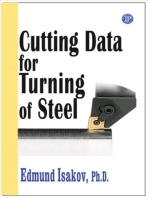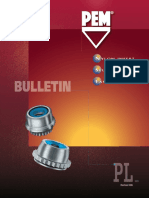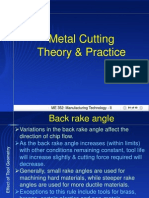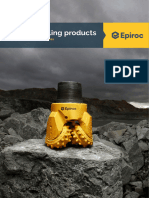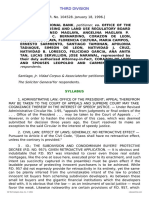Threading SECO
Threading SECO
Uploaded by
AGPLTTCopyright:
Available Formats
Threading SECO
Threading SECO
Uploaded by
AGPLTTOriginal Title
Copyright
Available Formats
Share this document
Did you find this document useful?
Is this content inappropriate?
Copyright:
Available Formats
Threading SECO
Threading SECO
Uploaded by
AGPLTTCopyright:
Available Formats
COPYRIGHT © 2008, Seco Tools AB
Threading 1/65
Threading
Introduction
Fastening Connecting
Actuating Containing
COPYRIGHT © 2008, Seco Tools AB 2/65
Seco Core curriculum of metalcutting - page 1
Threading
Introduction
Single Point Turning Thread Milling
Thread Grinding Thread Rolling
COPYRIGHT © 2006, Seco Tools AB 3/62
Threading
Introduction
Major
Minor diameter
External thread diameter
Major
Minor diameter
Internal thread diameter
COPYRIGHT © 2008, Seco Tools AB 4/65
Seco Core curriculum of metalcutting - page 2
Threading
Introduction
Right hand
Left hand
COPYRIGHT © 2008, Seco Tools AB 5/65
Threading
Introduction
COPYRIGHT © 2008, Seco Tools AB 6/65
Seco Core curriculum of metalcutting - page 3
Threading
Introduction Root
Lead
Addendum Crest
Pitch
diameter
Thread depth
Dedendum
Pitch
Helix angle
Thread
angle
Flank
angle
COPYRIGHT © 2008, Seco Tools AB 7/65
Threading
Introduction
Threading
Turning
COPYRIGHT © 2008, Seco Tools AB 8/65
Seco Core curriculum of metalcutting - page 4
Threading
Introduction
Lead = Table travel in 1 revolution
Table travel = RPM × Lead
COPYRIGHT © 2008, Seco Tools AB 9/65
Threading
The principle steps in selecting a
toolholder, insert and threading method.
COPYRIGHT © 2008, Seco Tools AB 10/65
Seco Core curriculum of metalcutting - page 5
Threading
1. The choice of method
The method selected depends on:
1. The thread (internal, external, left or right hand, ...).
2. Type of machine.
3. Threading towards or away from the chuck.
COPYRIGHT © 2008, Seco Tools AB 11/65
Threading
1. The choice of method
LH Thread RH Thread
RH Tool RH Tool
RH Thread LH Thread
LH Tool LH Tool
COPYRIGHT © 2008, Seco Tools AB 12/65
Seco Core curriculum of metalcutting - page 6
Threading
2. The choice of insert
– Thread profile (e.g. metric ISO).
– The threading pass (e.g. 1 mm).
– The type of toolholder (e.g. CER).
COPYRIGHT © 2008, Seco Tools AB 13/65
Threading
2. The choice of insert
– Thread profile (e.g. metric ISO).
– The threading pass (e.g. 1 mm).
– The type of toolholder (e.g. CER).
MN 2004 Turning page 349
COPYRIGHT © 2008, Seco Tools AB 14/65
Seco Core curriculum of metalcutting - page 7
Threading
2. The choice of insert
– Thread profile (e.g. metric ISO).
– The thread lead (e.g. 1 mm).
– The type of toolholder (e.g. CER).
MN 2004 Turning page 352
COPYRIGHT © 2008, Seco Tools AB 15/65
Threading
2. The choice of insert
Productivity TT
Reliability A1 Easy cutting A2
COPYRIGHT © 2008, Seco Tools AB 16/65
Seco Core curriculum of metalcutting - page 8
Threading
2. The choice of insert (thread profile, lead)
(Typical example )
COPYRIGHT © 2008, Seco Tools AB 17/65
Threading
2. The choice of insert (full or partial profile, number of teeth)
Full profile insert
Partial profile insert
MN 2004 Turning page 318
COPYRIGHT © 2008, Seco Tools AB 18/65
Seco Core curriculum of metalcutting - page 9
Threading
2. The choice of insert (full or partial profile, number of teeth)
Single-tooth Insert Multi-tooth Insert
COPYRIGHT © 2008, Seco Tools AB 19/65
Threading
2. The choice of insert (full or partial profile, number of teeth)
COPYRIGHT © 2008, Seco Tools AB 20/65
Seco Core curriculum of metalcutting - page 10
Threading
2. The choice of insert (full or partial profile, number of teeth)
Finished profile
COPYRIGHT © 2008, Seco Tools AB 21/65
Threading
3. The choice of toolholder
– Shank dimension according to machine.
– Insert size.
– Insert clamping system.
COPYRIGHT © 2008, Seco Tools AB 22/65
Seco Core curriculum of metalcutting - page 11
Threading
3. The choice of toolholder
– Shank dimension according
to machine.
– Insert size.
MN 2004 Turning page 348
COPYRIGHT © 2008, Seco Tools AB 23/65
Threading
3. The choice of toolholder
External and internal threading
Insert clamping: Finger clamp
Accessories: Anvil
Type of insert: Triangular or type K
Internal threading
Insert clamping: Screw
Accessories: No anvil
Type of insert: Triangular
COPYRIGHT © 2008, Seco Tools AB 24/65
Seco Core curriculum of metalcutting - page 12
Threading
3. The choice of toolholder
CER/L
10°
15°
SNR/L
15°
CNR/L
COPYRIGHT © 2008, Seco Tools AB 25/65
Threading
4. The choice of anvil
– Insert size.
– Left or right hand thread.
– Lead angle (Ø and lead).
COPYRIGHT © 2008, Seco Tools AB 26/65
Seco Core curriculum of metalcutting - page 13
Threading
4. Choice of the anvil (lead angle, inclination)
Lead angle (inclination)
Lead = Pitch Lead angle
Lead
λ° = Helix
Lead diam x π
(Single start thread) Lead angle
Lead = Pitch = Axial movement of the thread.
COPYRIGHT © 2008, Seco Tools AB 27/65
Threading
4. Choice of the anvil (lead angle, inclination)
Lead angle (inclination)
Determines:
- Correct clearance angle.
- Symetrical cut.
- Correct profile.
MN 2004 Turning page 325
Correct positioning of the insert ensures regular wear and better surface
finish.
COPYRIGHT © 2008, Seco Tools AB 28/65
Seco Core curriculum of metalcutting - page 14
Threading
4. Choice of the anvil (lead angle, inclination)
o
+ λ
2° 4°
COPYRIGHT © 2008, Seco Tools AB 29/65
Threading
4. Choice of the anvil (lead angle, inclination)
LH thread RH thread
RH tool RH tool
One toolholder offers the possibility for producing both LH
and RH threads by changing the anvil.
COPYRIGHT © 2008, Seco Tools AB 30/65
Seco Core curriculum of metalcutting - page 15
Threading
4. Choice of the anvil (lead angle, inclination)
o
−λ
o +λ
Reverse threading Normal threading
(generally first choice)
COPYRIGHT © 2008, Seco Tools AB 31/65
Threading
4. Choice of the anvil MN 2004 Turning page 386
COPYRIGHT © 2008, Seco Tools AB 32/65
Seco Core curriculum of metalcutting - page 16
Threading
5. The choice of the insert grade MN 2004 Turning page 382
– The workpiece material.
– Type of grade (specific or universal).
(Typical example )
(Typical example )
COPYRIGHT © 2008, Seco Tools AB 33/65
Threading
MN 2004 Turning page 395
5. The choice of the insert grade
– The workpiece material.
– Type of grade (specific or universal).
(Typical example )
COPYRIGHT © 2008, Seco Tools AB 34/65
Seco Core curriculum of metalcutting - page 17
Threading
6. Infeed method
– Type of machine
(conventional or NC).
– Production type (series
or single).
– Workpiece material /
chip geometry.
MN 2004 Turning page 393
COPYRIGHT © 2008, Seco Tools AB 35/65
Threading
6. Infeed method (radial infeed)
COPYRIGHT © 2008, Seco Tools AB 36/65
Seco Core curriculum of metalcutting - page 18
Threading
6. Infeed method (radial infeed)
– V-shaped chip (long and rolled) (long workpiece chip).
COPYRIGHT © 2008, Seco Tools AB 37/65
Threading
6. Infeed method (alternate flank infeed) (large batches)
ETC.
etc.
33
22
11
COPYRIGHT © 2008, Seco Tools AB 38/65
Seco Core curriculum of metalcutting - page 19
Threading
6. Infeed method (flank infeed)
COPYRIGHT © 2008, Seco Tools AB 39/65
Threading
6. Infeed method (flank infeed)
– “Normal” chips
COPYRIGHT © 2008, Seco Tools AB 40/65
Seco Core curriculum of metalcutting - page 20
Threading
6. Infeed method (modified flank infeed)
COPYRIGHT © 2008, Seco Tools AB 41/65
Threading
6. Infeed method (modified flank infeed)
Pass 1 Pass 2
Pass 3 Pass 4
COPYRIGHT © 2008, Seco Tools AB 42/65
Seco Core curriculum of metalcutting - page 21
Threading
6. Infeed method (modified flank infeed)
– Traditional chips.
– Easy to control.
COPYRIGHT © 2008, Seco Tools AB 43/65
Threading
6. Infeed method (modified flank infeed)
– Optimization with the chipbreaking geometry.
Flank infeed Radial infeed
A1 - Flank infeed A1 - Radial infeed
COPYRIGHT © 2008, Seco Tools AB 44/65
Seco Core curriculum of metalcutting - page 22
Threading
7. Passes Constant infeed per pass.
5th 4th 3rd 2nd 1st DOC
Volume machined
per pass at constant
DOC.
1 2 3 4 5
Pass
COPYRIGHT © 2008, Seco Tools AB 45/65
Threading
7. Passes Constant load on cutting edge.
5th 4th 3rd 2nd 1st DOC
Volume
machined
per pass at
decreasing DOC. 1 2 3 4 5
Pass
COPYRIGHT © 2008, Seco Tools AB 46/65
Seco Core curriculum of metalcutting - page 23
Threading
7. Passes MN 2004 Turning page 388
(Typical example )
COPYRIGHT © 2008, Seco Tools AB 47/65
Threading
8. Roughing (with turning toolholder, with grooving insert,
with MDT, ...)
Always check the clearance angle (in relation to the lead angle of the thread).
COPYRIGHT © 2008, Seco Tools AB 48/65
Seco Core curriculum of metalcutting - page 24
Threading
9. Troubleshooting
Refer to Navigator page 395
COPYRIGHT © 2008, Seco Tools AB 49/65
Threading
9. Troubleshooting (plastic deformation) MN 2004 Turning page 395
• Reduce the cutting speed.
• Increase the number of passes.
• Check that the workpiece diameter is correct.
• Increase the coolant supply.
• Select a different insert grade.
(resistant to plastic deformation).
COPYRIGHT © 2008, Seco Tools AB 50/65
Seco Core curriculum of metalcutting - page 25
Threading
9. Troubleshooting (flank wear) MN 2004 Turning page 395
• Use modified flank infeed.
• Increase the infeed per pass.
• Reduce the cutting speed.
• Select a different insert grade (more wear resistant).
• Check that the correct anvil has been selected.
COPYRIGHT © 2008, Seco Tools AB 51/65
Threading
9. Troubleshooting (edge chipping) MN 2004 Turning page 395
• Use modified flank infeed.
• Improve the stability of the workpiece mounting.
• Select a tougher insert grade.
• Check the cutting speed.
COPYRIGHT © 2008, Seco Tools AB 52/65
Seco Core curriculum of metalcutting - page 26
Threading
9. Troubleshooting (insert fracture) MN 2004 Turning page 395
• Check the centre height of the cutting edge.
• Improve the stability of the workpiece mounting.
• Increase the number of passes.
• Select a tougher insert grade.
• Check for built-up edge.
COPYRIGHT © 2008, Seco Tools AB 53/65
Threading
9. Troubleshooting (built- up edge) MN 2004 Turning page 395
• Do not use coolant.
• Increase the cutting speed.
• Use a PVD coated insert.
COPYRIGHT © 2008, Seco Tools AB 54/65
Seco Core curriculum of metalcutting - page 27
Threading
9. Troubleshooting (vibrations) MN 2004 Turning page 395
Improve the stability of the workpiece and tool.
Check the centre height of the cutting edge.
Check that the workpiece diameter is correct.
Increase the cutting speed.
COPYRIGHT © 2008, Seco Tools AB 55/65
Threading
9. Troubleshooting (poor finish) MN 2004 Turning page 395
Improve the stability of the workpiece and tool.
Check that the correct anvil has been selected.
Use modified flank infeed or radial infeed.
Increase the cutting speed.
Increase the coolant supply.
COPYRIGHT © 2008, Seco Tools AB 56/65
Seco Core curriculum of metalcutting - page 28
Threading
Seco Carboloy Threading Wizard!
COPYRIGHT © 2008, Seco Tools AB 59/65
Threading
Seco Carboloy Threading Wizard!
COPYRIGHT © 2008, Seco Tools AB 60/65
Seco Core curriculum of metalcutting - page 29
Threading
Seco Carboloy Threading Wizard!
COPYRIGHT © 2008, Seco Tools AB 61/65
Threading
Seco Carboloy Threading Wizard!
COPYRIGHT © 2008, Seco Tools AB 62/65
Seco Core curriculum of metalcutting - page 30
Threading
Seco Carboloy Threading Wizard!
COPYRIGHT © 2008, Seco Tools AB 63/65
Threading
Seco Carboloy Threading Wizard!
COPYRIGHT © 2008, Seco Tools AB 64/65
Seco Core curriculum of metalcutting - page 31
COPYRIGHT © 2008, Seco Tools AB Questions?
65/65
Seco Core curriculum of metalcutting - page 32
You might also like
- 01 Coalescer Elements CombinedDocument14 pages01 Coalescer Elements Combinedeino6622No ratings yet
- Rpms Tools For Master Teacher I-IVDocument46 pagesRpms Tools For Master Teacher I-IVeleonora100% (1)
- BIE Technical DatasDocument4 pagesBIE Technical DatasTran The AnhNo ratings yet
- Machining Processes and Lathe PDFDocument79 pagesMachining Processes and Lathe PDFSOUMEN KOLENo ratings yet
- Lben-M0602 04 GBR en Ca 180123 HDocument12 pagesLben-M0602 04 GBR en Ca 180123 HnataliaNo ratings yet
- 2023.08. YT Catalog Europe Version ENDocument321 pages2023.08. YT Catalog Europe Version ENIrfanNo ratings yet
- Chapter 7-8 - Drilling Bits CostDocument75 pagesChapter 7-8 - Drilling Bits Costbakri OmanNo ratings yet
- Irjet V6i835Document6 pagesIrjet V6i835Rahul KumarNo ratings yet
- Cim 232 SpeedsFeedsDocument40 pagesCim 232 SpeedsFeedsvarunb0808No ratings yet
- ACES Seminar 8 Mar 2018 - Nippon SteelDocument34 pagesACES Seminar 8 Mar 2018 - Nippon SteelBatu GajahNo ratings yet
- 1 PDFDocument20 pages1 PDFRacem RebaiNo ratings yet
- FT BIE en Rev6Document7 pagesFT BIE en Rev6Mohd AzharNo ratings yet
- Tube of Different SizesDocument20 pagesTube of Different SizesGajraj ChauhanNo ratings yet
- MEE 2165- Lecture 4Document55 pagesMEE 2165- Lecture 4marvinmugisha955No ratings yet
- ISCAR. Turning and Threading ToolsDocument466 pagesISCAR. Turning and Threading ToolsJuan Carlos Encalada100% (2)
- Закладные элементы IMTEC imtec-thread-inserts-for-in-moulding-en-0225Document8 pagesЗакладные элементы IMTEC imtec-thread-inserts-for-in-moulding-en-0225AndreyNo ratings yet
- Acero 10-2-GK23A UMB Manual 20140711Document16 pagesAcero 10-2-GK23A UMB Manual 20140711gonzalo hernandez aguilarNo ratings yet
- How Is Ball Screw Life Calculated - Ball Screws - Technical Information - Kuroda Precision Industries LTDDocument2 pagesHow Is Ball Screw Life Calculated - Ball Screws - Technical Information - Kuroda Precision Industries LTDDuong NguyenNo ratings yet
- Soundcraft GB8 TD OriginalDocument6 pagesSoundcraft GB8 TD OriginalDomingo ArroyoNo ratings yet
- Leaf Limit Switch CatalogDocument19 pagesLeaf Limit Switch Catalogbrian sNo ratings yet
- Metals: Die Defects and Die Corrections in Metal ExtrusionDocument18 pagesMetals: Die Defects and Die Corrections in Metal ExtrusionRimon GawandeNo ratings yet
- Metals: Die Defects and Die Corrections in Metal ExtrusionDocument18 pagesMetals: Die Defects and Die Corrections in Metal ExtrusionThaanawat NaphaarakNo ratings yet
- Ylon Insert: Revised 406Document6 pagesYlon Insert: Revised 406williaqNo ratings yet
- SW M Eng AbjDocument24 pagesSW M Eng Abjcpj168No ratings yet
- 7-Welded ConnectionsDocument54 pages7-Welded ConnectionsetemNo ratings yet
- Drawing Puzzolana - 180 EHDDocument1 pageDrawing Puzzolana - 180 EHDpmf engineering limitedNo ratings yet
- SKF SONL 238-538 + 22238 CC - W33 SpecificationDocument6 pagesSKF SONL 238-538 + 22238 CC - W33 Specificationfaisal hajjNo ratings yet
- 02-BS-EN-2020Document52 pages02-BS-EN-2020Tuấn LêNo ratings yet
- Ball-Screws SFE-2Document20 pagesBall-Screws SFE-2Joss JossNo ratings yet
- Ch1. Sheet Metal Cutting OperationsDocument41 pagesCh1. Sheet Metal Cutting OperationsSRI RAMNo ratings yet
- Narrow Gap Gas Metal Arc (GMA) Welding Technologies: AbstractDocument7 pagesNarrow Gap Gas Metal Arc (GMA) Welding Technologies: Abstracttiepnh.ameccNo ratings yet
- PEM - Threaded Inserts For Plastics PDFDocument20 pagesPEM - Threaded Inserts For Plastics PDFHenrique MarquesNo ratings yet
- Chip Formation and Tool LifeDocument37 pagesChip Formation and Tool Lifeneelesh singh100% (10)
- 26 05 48.00 10-1 Cable Tray Seismic AnchoringDocument23 pages26 05 48.00 10-1 Cable Tray Seismic AnchoringRicardo BermudezNo ratings yet
- PETE 5313_Handout#4_Bits and Rollercone ROP ModelDocument62 pagesPETE 5313_Handout#4_Bits and Rollercone ROP Modelkaniz.m.mimNo ratings yet
- Presentation - 6 BIT DESIGNDocument44 pagesPresentation - 6 BIT DESIGNMohamed HamdyNo ratings yet
- Self Drilling Screws: DescriptionDocument2 pagesSelf Drilling Screws: DescriptionPaulNo ratings yet
- Effect of Tool GeometryDocument10 pagesEffect of Tool GeometryVenu Gopal Anne100% (1)
- SITEC Rivet Blindnietmuttern Mit Kunststoffumspritzung Mit Scheibe enDocument2 pagesSITEC Rivet Blindnietmuttern Mit Kunststoffumspritzung Mit Scheibe enamaliabohusNo ratings yet
- TWI CSWIP 3.1 WIS 10 Senior Welding Inspection Welding Symbols & Weld Preparation Section 6Document55 pagesTWI CSWIP 3.1 WIS 10 Senior Welding Inspection Welding Symbols & Weld Preparation Section 6JJNo ratings yet
- Summary of Cutting Data For Profile Surface - Torical/radiusDocument4 pagesSummary of Cutting Data For Profile Surface - Torical/radiusAndrei MihaiNo ratings yet
- Rotary Drilling ProductsDocument27 pagesRotary Drilling Productsabbas ansariNo ratings yet
- MaquinadoDocument42 pagesMaquinadooscarNo ratings yet
- Self Tapping Screw 6336Document2 pagesSelf Tapping Screw 6336Dinesh GanapathyNo ratings yet
- Welding TerminologyDocument26 pagesWelding Terminologydaha333No ratings yet
- Oil and Gas Product Lines: Welcome To Training ForDocument9 pagesOil and Gas Product Lines: Welcome To Training ForM. AguiarNo ratings yet
- SKF SY 508 M SpecificationDocument4 pagesSKF SY 508 M Specificationrinaldo KurniawanNo ratings yet
- Katalog Flexible Tozen SFI-100Document1 pageKatalog Flexible Tozen SFI-100Ryan AryandiNo ratings yet
- Welding Symbols & Weld PreparationsDocument54 pagesWelding Symbols & Weld PreparationsAmirtha Thiyagaraajan AlagesanNo ratings yet
- Parts list HitachiDocument41 pagesParts list HitachiAlberto Cabezuelo SanchezNo ratings yet
- Answers Drawing B: BS 499 Part 2. Course Reference WIS 10Document10 pagesAnswers Drawing B: BS 499 Part 2. Course Reference WIS 10Harkynollar Harkyntehye100% (1)
- Know Your Bending Basics-Part I - The FabricatorDocument6 pagesKnow Your Bending Basics-Part I - The FabricatorSIMONENo ratings yet
- Rr220 Series Standard Air Bearing Bits: Drilling ApplicationsDocument2 pagesRr220 Series Standard Air Bearing Bits: Drilling ApplicationsandraNo ratings yet
- 2.3.5.1.2_SGT400_Technical Status_Pt2(2)Document47 pages2.3.5.1.2_SGT400_Technical Status_Pt2(2)hoomanNo ratings yet
- Catalogo Lista Codici Protesi-Fissa-Ot-Bridge 2022 ENG MOD D375SP Rev 08 Del 11-02-2022 VERSIONE WEB CompressedDocument20 pagesCatalogo Lista Codici Protesi-Fissa-Ot-Bridge 2022 ENG MOD D375SP Rev 08 Del 11-02-2022 VERSIONE WEB CompressedThanh Nhan DinhNo ratings yet
- Schoeck Isokorb T Type CO Technical Manual (8631)Document7 pagesSchoeck Isokorb T Type CO Technical Manual (8631)theoNo ratings yet
- 08G2. IADC Dull GradingDocument56 pages08G2. IADC Dull GradingDonald StraubNo ratings yet
- 2nd Btech MECH 2021-22 MCMT Ses-K4 PDFDocument14 pages2nd Btech MECH 2021-22 MCMT Ses-K4 PDFGopi TNo ratings yet
- VITA MillingDocument8 pagesVITA MillingGeorgi AnaNo ratings yet
- The Beginners Guide to Band Saws: Manual on how to Choose, Install, Maintain and Troubleshooting Tips for your Bandsaw with Basic ProjectsFrom EverandThe Beginners Guide to Band Saws: Manual on how to Choose, Install, Maintain and Troubleshooting Tips for your Bandsaw with Basic ProjectsNo ratings yet
- Water and or Bodies of Water As Motif in Genevieve Asenjo's Selected PoemsDocument22 pagesWater and or Bodies of Water As Motif in Genevieve Asenjo's Selected PoemsBeiya ClaveriaNo ratings yet
- Analog Circuits (KEC 402) Full NotesDocument330 pagesAnalog Circuits (KEC 402) Full NotesAnushka MauryaNo ratings yet
- Spanner Selection for Metric and Imperial Hex BoltsDocument1 pageSpanner Selection for Metric and Imperial Hex Boltssaravanansha436No ratings yet
- Physics For Scientists and Engineers Foundations and Connections Advance Edition Volume 2 1st Edition Katz Solutions ManualDocument38 pagesPhysics For Scientists and Engineers Foundations and Connections Advance Edition Volume 2 1st Edition Katz Solutions Manualmageaugalema100% (1)
- PNB v. Office of The President, G.R. No, 104528, 18 January 1996Document9 pagesPNB v. Office of The President, G.R. No, 104528, 18 January 1996Jennilyn Gulfan YaseNo ratings yet
- Special Proceedings Case DigestsDocument11 pagesSpecial Proceedings Case DigestskristetaNo ratings yet
- Research PaperDocument16 pagesResearch PapersfhgdNo ratings yet
- Online based-Cbc-Bookkeeping-Nc-IIIDocument67 pagesOnline based-Cbc-Bookkeeping-Nc-IIImark clyne c. agawinNo ratings yet
- A Secret Place Lesson 1Document16 pagesA Secret Place Lesson 1YenThiLeNo ratings yet
- IC Engines4Document10 pagesIC Engines4GovindNo ratings yet
- This Order Is Modified/corrected by Speaking To Minutes Order DatedDocument4 pagesThis Order Is Modified/corrected by Speaking To Minutes Order Datedjimit0810No ratings yet
- Transcriptions From Operas by Auber and Verdi: Franz LisztDocument6 pagesTranscriptions From Operas by Auber and Verdi: Franz LisztRocco CataniaNo ratings yet
- M. Alba Education Service ContractingDocument21 pagesM. Alba Education Service ContractingMaria Zarah MenesesNo ratings yet
- Eastern OrthodoxDocument25 pagesEastern OrthodoxAnni BarbaNo ratings yet
- UnpublishedDocument10 pagesUnpublishedScribd Government DocsNo ratings yet
- Beer and BrewingDocument73 pagesBeer and BrewingodairnettoNo ratings yet
- Purchase Confirmation From FalinasDocument4 pagesPurchase Confirmation From FalinasCarina LevandoskiNo ratings yet
- Food Hygiene Standards in SingaporeDocument6 pagesFood Hygiene Standards in SingaporeAndreas OctavianoNo ratings yet
- Glen Paul R. Abawan Mat-Social Sciences Dr. Jose Alejandro S. Tenorio Autodidactic in UTILITARIANISMDocument2 pagesGlen Paul R. Abawan Mat-Social Sciences Dr. Jose Alejandro S. Tenorio Autodidactic in UTILITARIANISMGlen PaulNo ratings yet
- Palingowak Elementary School: Department of EducationDocument6 pagesPalingowak Elementary School: Department of EducationMay Anne AlmarioNo ratings yet
- BP CGWBDocument96 pagesBP CGWBNimish GoyalNo ratings yet
- Cherian Thomas ResumeDocument4 pagesCherian Thomas ResumenaveedahmedkwNo ratings yet
- Lilavati Book by Bhaskaracharya PDFDocument4 pagesLilavati Book by Bhaskaracharya PDFRajesh Kumar50% (2)
- Immediate Download Tactics For TOEIC Listening and Reading Test Grant Trew Ebooks 2024Document84 pagesImmediate Download Tactics For TOEIC Listening and Reading Test Grant Trew Ebooks 2024donkerzelijeNo ratings yet
- Birth Certificate FormDocument5 pagesBirth Certificate FormEric MitieloNo ratings yet
- Uma Revisão Dos Ácaros Ectoparasitas Associados A Aves e Seus Ninhos Na EslováquiaDocument24 pagesUma Revisão Dos Ácaros Ectoparasitas Associados A Aves e Seus Ninhos Na EslováquiaYasmin S.O.MarinhoNo ratings yet
- FORMTR12 ChalanDocument2 pagesFORMTR12 ChalanVinod SathyanNo ratings yet
- Colloids and Surfaces A: Physicochemical and Engineering AspectsDocument9 pagesColloids and Surfaces A: Physicochemical and Engineering AspectsChí ChungNo ratings yet
- Nokia Information SystemDocument3 pagesNokia Information SystemRia Singh67% (3)

